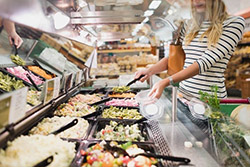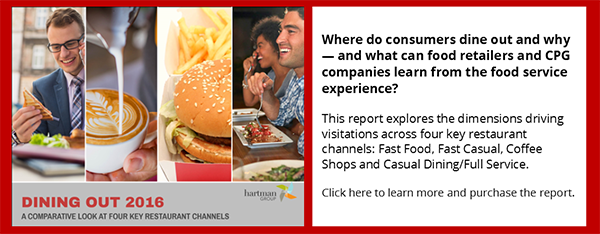Revisiting the third grocery sector: the rise of the grocerant trend
2017-05-30
 A recent Wall Street Journal article connected food retailers’ increasing emphasis of store perimeters with flatlining sales of iconic center store CPG brands and underscored that the emerging concept of supermarkets as “grocerants” is maturing into the mainstream. This is hardly a startling new revelation to us or to many across the food and beverage industry. For more than a decade now, here at The Hartman Group, we’ve been telling the tale of the fresh revolution and the redefinition of quality away from packaged and processed food products that led to the center store migration.
A recent Wall Street Journal article connected food retailers’ increasing emphasis of store perimeters with flatlining sales of iconic center store CPG brands and underscored that the emerging concept of supermarkets as “grocerants” is maturing into the mainstream. This is hardly a startling new revelation to us or to many across the food and beverage industry. For more than a decade now, here at The Hartman Group, we’ve been telling the tale of the fresh revolution and the redefinition of quality away from packaged and processed food products that led to the center store migration.
For the past twenty years we’ve observed a single, overarching theme encompassing the vast cultural shift in the food world: namely, the pursuit of all things real — expressed here primarily though cultural distinctions of “fresh.”
Fresh is the most salient cultural distinction in the food world. It is an indicator of quality, healthfulness and taste, and such a distinction often affects consumer shopping behavior in critical directions. We find that products in refrigerated sections always score high marks in terms of freshness perceptions, the operative logic being that refrigerated areas are reserved for the most perishable of products.
The move toward fresh implies the gradual replacement of traditional CPG products with “fresh” counterparts, on a category-by-category basis. From CPG products to grocery retail to quick service and fast casual restaurants and even local farm economies, the growing and evolving consumer interest in quality fresh products and offerings is transforming the food and beverage marketplace. And nothing is more evident of this transformation than the prepared foods sections of the supermarket, or what we referred to six years ago in an issue of our Hartbeat Exec as the “third grocery sector.”
The third grocery sector is about redefining quality on low-stakes occasions while also minimizing the harsh comparison between higher-quality restaurant meals we used to, and still want to, consume — even on low-stakes eating occasions. Restaurants have been in a tug of war with supermarkets for share of the consumers’ food dollars for years.
Traditional supermarkets, specialty grocery and convenience stores have had to elevate their fresh prepared offerings due, in no small part, to the popularity of fast casual restaurant brands like Panera, Chipotle and sweetgreen. Much of the success of fast casual formats stems from the fact that fresh food experiences — which the chains specialize in delivering — are the essence of consumer evaluations of quality in restaurants today. Not only has the rise of the fast casual channel disrupted food retailing, it has altered consumer perceptions of eating out.
As with any industry, there are savvy players who read the tea leaves correctly and get out ahead of the herd. Food retailers like Wegmans, Whole Foods Market, Mariano’s and H-E-B’s Central Market have emerged as talented grocerant operators bridging the gap between restaurants and supermarkets with high-quality fresh prepared food offerings.
While shoppers are flocking to both dine-in and takeout from prepared foods sections staged by grocerants, we believe there is much to be learned from fast casual restaurants for food retailers trying to distinguish themselves with shoppers through their prepare foods and in-store dining programs and offerings.
Food retailers should be mindful that over the past decade or so, consumer expectations of restaurant chains have evolved beyond seeing them as sources of fast, cheap, familiar and convenient comfort foods.
 |
Innovations in fast casual formats have helped bridge the convenience of eating out with consumers’ aspirations for healthier diets. The Hartman Group’s Dining Out 2016 report finds that consumers now list “freshness” as a key marker of quality in restaurants. Across the four restaurant channels we surveyed (QSR, Fast Casual, Coffee Shops and Casual Dining/Full Service), when consumers talk about food that tastes “fresh,” they describe the experience of eating food that is made with simple, “real” ingredients (simple, fresh vegetables, fruit, whole grains, all natural/no artificial ingredients) and is minimally processed (cooked to order, open production, not sitting under heat lamps), all natural, free from artificial ingredients, more nutritious and has not sat around (thus less prone to food-borne pathogens).
It is important for food retailers to understand that restaurants have become fully woven into the fabric of American’s daily food lives and consequently consumers have become very savvy diners. Though many are regulars at restaurants, it is the rare consumer who visits only one restaurant channel and they do, in fact, seamlessly visit various restaurants for different occasions.
The rise of fast casual formats tracks the broader cultural shift away from highly processed foods and toward fresh, real and simple foods. While still meeting the demand for speed and convenience, these formats trade on evolving notions of freshness and quality offering:
- Open production and customizable, made-to-order food
- A focus on higher-quality, sometimes unique, menu items, ingredients and flavors
- Enjoyable yet healthier, better-for-you menu options
- Attributes of purity, sustainability and transparency
- Clean, modern design — including light, natural and reclaimed materials — combined with fun, playful décor.
Food retailers looking to capture some of the magic of fast casual restaurants for their grocerant offerings might consider these key points:
- Understand your value proposition. Price represents a potential hurdle for trial, and one of the biggest opportunities for increasing customer satisfaction in the fast casual segment. Various fast cCasual chains tap different aspects of modern food culture through cues of freshness, quality, indulgence, discovery, experimentation, health and sustainability. Consider what the appropriate mix and emphasis on these attributes are and how those are connected to the value proposition of your brand. Ultimately, retailers should not lose sight of the notion that value, speed and convenience are important priorities for consumers and areas of competition with restaurant operators.
- Make freshness a continuous line across all consumer touchpoints. The fast casual channel has already taken the lead in innovating around freshness via open production, customizability and made-to-order food.
- Ensure that atmosphere and design around in-store dining and serving areas are fully integrated into the eating experience. Among fast casual's many disruptive innovations has been the ability of such restaurants to integrate design, décor and atmosphere into their brand identity and narrative. Successful fast casual operators delight consumers with touches such as clean, modern design and the use of light as well as natural, reclaimed materials to evoke an emphasis on quality and freshness and distinguish themselves from the uniform, impersonal experience of a wide array of outdated dining experiences ranging from QSR outlets to aging grocery cafe's.
No comments:
Post a Comment